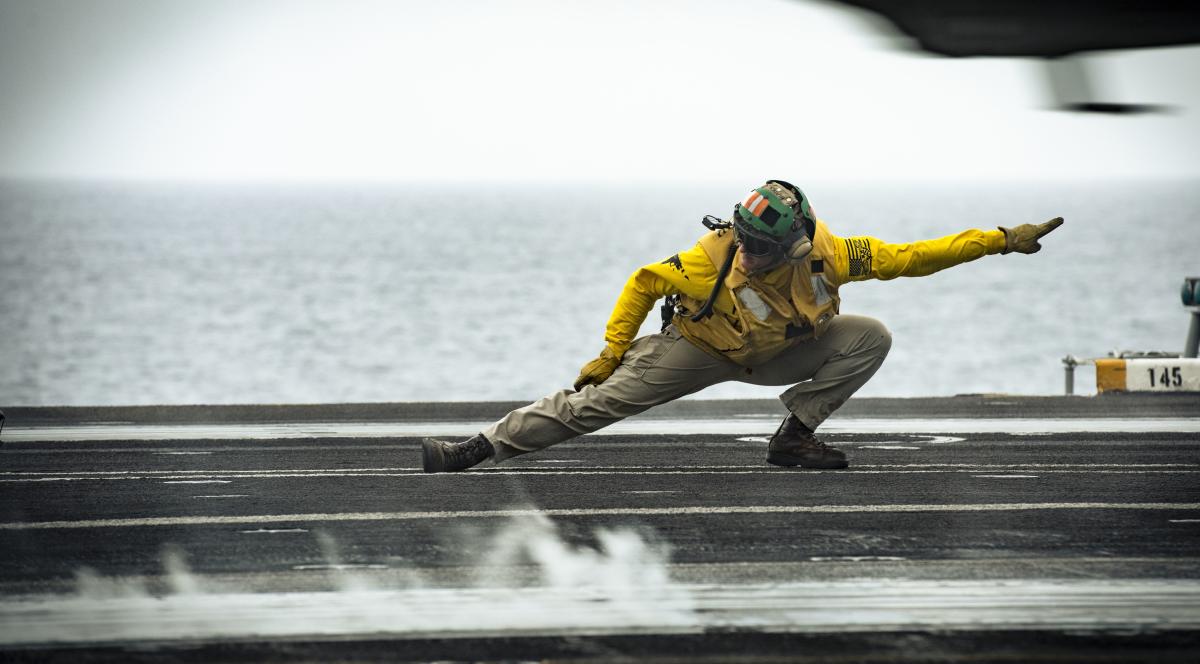Because I spent much of my Navy career on aircraft carriers, the naval aviation-focused September issue is always one of my favorites. As we got ready to send it to the printers in mid-August, the annual Tailhook Symposium in Reno, Nevada, was just weeks away. This issue has the same theme as ’Hook22: “Celebrating 100 years of U.S. Navy Air-craft Carriers.” Since the collier Jupiter (AC-3) was converted to the USS Langley (CV-1) and recommissioned in 1922, the topic of aircraft carriers has garnered a lot of ink in the pages of Proceedings. Should they play a supporting role to the battlefleet or be capital ships themselves? After World War II and the advent of nuclear weapons, were carriers still relevant or could strategic (i.e., Air Force) bombers take their place? Conventional power or nuclear? Propellor aircraft or jets? CVNs or “Lightning carriers?” Steam catapults or electromagnetic? The debates have been lively, and they continue.
The Naval Institute’s own Denis Clift provides a compilation of some of the best Proceedings articles from the past century on the topic of carriers in “A Century of Carrier Aviation in the Pages of Proceedings.” Lieutenant Commander Steve “Bubbles” Walsh’s “Stop Sending Carriers to CENTCOM” is thought-provoking. “The Return of Range: How the Navy Got the MQ-25 Right” is the latest contribution by Lieutenant Commanders Collin Fox, Dylan Phillips-Levine, and Trevor Phillips-Levine, and Captain Walker Mills, (from now on referred to as “the law firm of Fox, Phillips-Levine2, and Mills”). They discuss how the MQ-25B unmanned refueling aircraft will put naval aviation back in the long-range strike mission (without relying on Air Force tankers). The diagram of the British tanker plan for the Falklands War Vulcan bombing mission on page 58 is noteworthy.
Captain Tom Clarity provides the opening Professional Note this month—advice for post-command aviators who find themselves in the demanding jobs of carrier operations officer, navigator, or air boss. Anyone who has spent time on a carrier at sea quickly grasps the importance of these three positions, and “Survive and Thrive in the Aviation Post-Command Carrier Tour” provides useful insights and advice for senior aviators going to those key jobs.
Unmanned aircraft and artificial intelligence (AI) were probably unimaginable to Lieutenant Commander Godfrey Chevalier (Naval Aviator No. 7) when he made the first arrested landing on the Langley in October 1922. But two articles in this issue by junior officers address human–machine teaming and changes coming to aviation culture with the advent of unmanned and AI. In “Trust, But Verify,” Navy Lieutenant Mark Jbeily and Christian Heller write that the aviator–machine relationship must evolve to enable the next generation of warfare. The winner of this year’s Naval Postgraduate School Essay Contest, Ensign Sarah Clark—currently in flight school—writes about how uncrewed aircraft will bring a cultural shift to naval aviation and gives advice on how to manage the change in “Unmanned Future Threatens Pilot Identity.” Both are insightful.
Finally, the American Sea Power Project continues this month with “Cyber Warfare Is a Navy Mission” by Lieutenant Commander Tyson Meadors. The Project is in its second phase, focused on the “ways” of strategy, and Tyson explains that protection of maritime trade is increasingly a cyber task. Until next month, fly Navy, change your passwords, and enable two-factor authentication!




